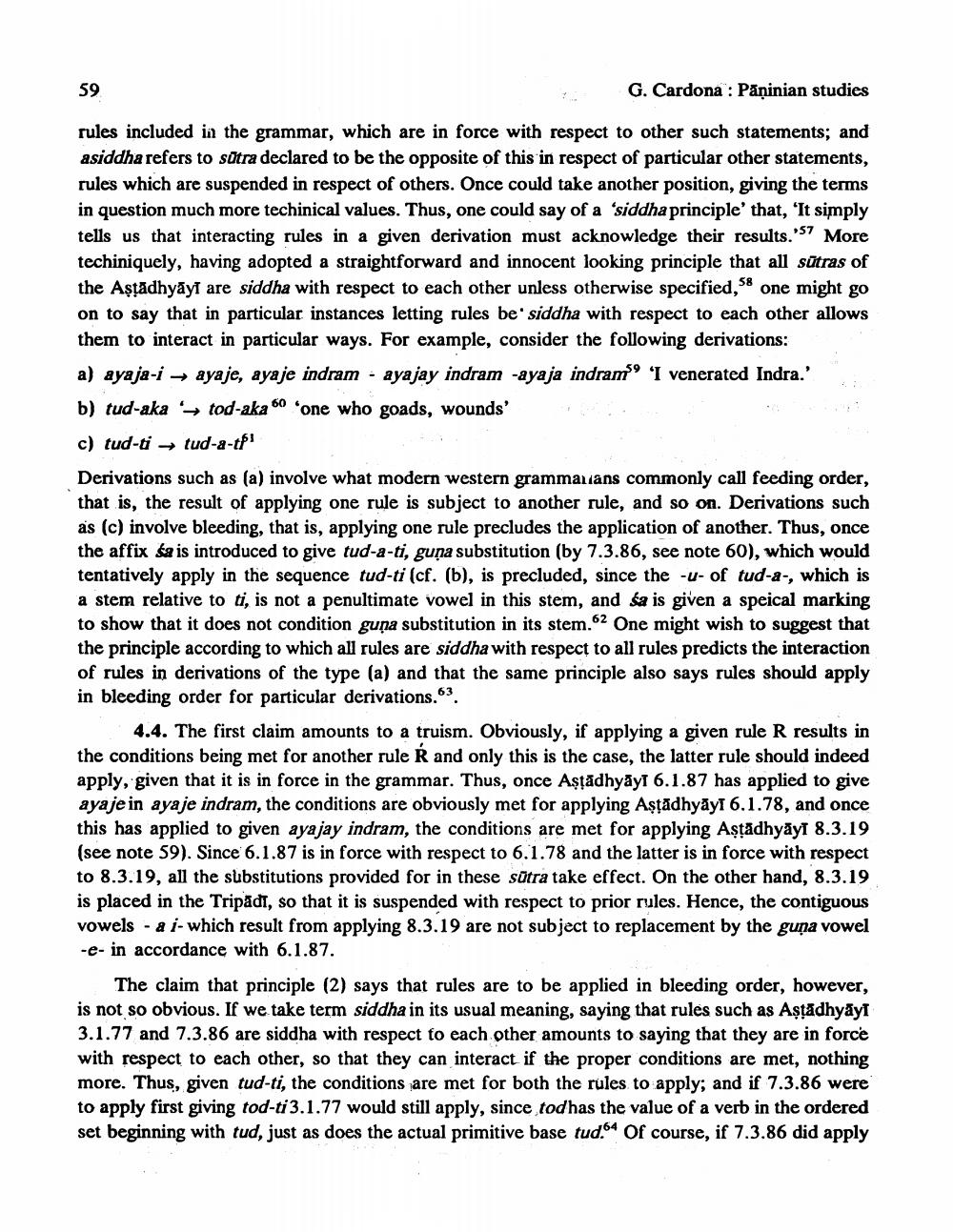________________
G. Cardona : Paninian studies
⚫57
rules included in the grammar, which are in force with respect to other such statements; and asiddha refers to sorra declared to be the opposite of this in respect of particular other statements, rules which are suspended in respect of others. Once could take another position, giving the terms in question much more techinical values. Thus, one could say of a 'siddha principle' that, 'It simply tells us that interacting rules in a given derivation must acknowledge their results. More techiniquely, having adopted a straightforward and innocent looking principle that all sutras of the Aṣṭādhyay! are siddha with respect to each other unless otherwise specified, one might go on to say that in particular instances letting rules be' siddha with respect to each other allows them to interact in particular ways. For example, consider the following derivations:
58
59
a) ayaja-i → ayaje, ayaje indramayajay indram -ayaja indram 'I venerated Indra.' b) tud-aka tod-aka 60 'one who goads, wounds'
c) tud-ti tud-a-th ->
Derivations such as (a) involve what modern western grammarians commonly call feeding order, that is, the result of applying one rule is subject to another rule, and so on. Derivations such as (c) involve bleeding, that is, applying one rule precludes the application of another. Thus, once the affix sa is introduced to give tud-a-ti, guna substitution (by 7.3.86, see note 60), which would tentatively apply in the sequence tud-ti (cf. (b), is precluded, since the -u- of tud-a-, which is a stem relative to ti, is not a penultimate vowel in this stem, and a is given a speical marking to show that it does not condition guna substitution in its stem.62 One might wish to suggest that the principle according to which all rules are siddha with respect to all rules predicts the interaction of rules in derivations of the type (a) and that the same principle also says rules should apply in bleeding order for particular derivations."3
4.4. The first claim amounts to a truism. Obviously, if applying a given rule R results in the conditions being met for another rule Ŕ and only this is the case, the latter rule should indeed apply, given that it is in force in the grammar. Thus, once Aṣṭādhyay 6.1.87 has applied to give ayaje in ayaje indram, the conditions are obviously met for applying Aṣṭādhyāyr 6.1.78, and once this has applied to given ayajay indram, the conditions are met for applying Aṣṭädhyāyr 8.3.19 (see note 59). Since 6.1.87 is in force with respect to 6.1.78 and the latter is in force with respect to 8.3.19, all the substitutions provided for in these sutra take effect. On the other hand, 8.3.19 is placed in the Tripăd, so that it is suspended with respect to prior rules. Hence, the contiguous vowels - a i- which result from applying 8.3.19 are not subject to replacement by the guna vowel -e- in accordance with 6.1.87.
The claim that principle (2) says that rules are to be applied in bleeding order, however, is not so obvious. If we take term siddha in its usual meaning, saying that rules such as Aṣṭādhyāy! 3.1.77 and 7.3.86 are siddha with respect to each other amounts to saying that they are in force with respect to each other, so that they can interact if the proper conditions are met, nothing more. Thus, given tud-ti, the conditions are met for both the rules to apply; and if 7.3.86 were to apply first giving tod-ti3.1.77 would still apply, since todhas the value of a verb in the ordered set beginning with tud, just as does the actual primitive base tud. Of course, if 7.3.86 did apply




